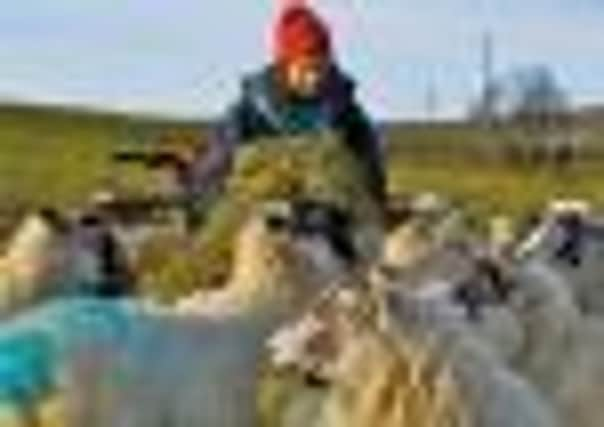Key role for young shepherdess


Her father Richard’s hill farm in Upper Nidderdale remained mercifully free of foot and mouth disease (FMD), even though reports of the epidemic crept ever-closer through the spring and early summer of 2001.
Says Evie: “I’ve grown up listening to all these horror stories about what happened, and I’ve met a vet who was working right in the thick of it all. I can imagine how terrible it would’ve been if they’d turned up one day and said they wanted to destroy my sheep.”
Advertisement
Hide AdAdvertisement
Hide AdNow 13 years old, Evie looks after her own flock. She has 25 “mules” – one of the most popular crossbred sheep. Her father Richard says he makes sure she is involved in every aspect of the flock’s work.
After school she goes down to the fields in which they are kept to check and feed them. She is learning how to dose them with medication and she lambs them herself.
Evie has been showing her sheep for two years and won numerous prizes, including Best Young Handler and Best Girl Handler at last year’s Nidderdale Show.
One of her family’s neighbours is Professor Dianna Bowles, the founder of the Sheep Trust. Prof Bowles set up this national charity in 2001 in order to protect heritage sheep breeds like Herdwicks from extinction.
Advertisement
Hide AdAdvertisement
Hide AdAs we approach the 10th anniversary of the outbreak of the epidemic, the trust is using small samples from its genetic bank to confirm the continuing viability of the resources of semen and embryos that were collected during the dark days of 2001.
It is through the Church family’s friendship with Dianna that Evie offered to provide two of her mule ewes to the Sheep Trust, to become surrogate mothers for Herdwick lambs.
The mules were implanted with embryos conceived at the height of FMD in Cumbria and conserved in liquid nitrogen until transferred to the ewes. Two sets of twin lambs are expected to be born around Easter.
“I’m so excited,” Evie says. “It’s good to know that something good can come out of that awful time for farmers.”
Advertisement
Hide AdAdvertisement
Hide AdProfessor Bowles is Chair of Biochemistry at York University and became interested in keeping sheep in the 1980s, after she bought a house at Middlesmoor in Upper Nidderdale.
Since then she has steadily built up her own flock of Herdwicks, a breed traditionally associated with the Lake District.
In March 2001, shortly after the FMD outbreak began, the Lakes quickly became the worst-hit region in England. Within the first weeks, over 280,000 sheep were slaughtered in Cumbria. In April, the number had risen to nearly 800,000 and people started fearing that breeds such as the Herdwicks could face extinction.
Professor Bowles was phoned by a prominent Cumbrian farmer, Andrew Nicholson, who asked if she, as a scientist, knew how the breed could be saved from disaster.
Advertisement
Hide AdAdvertisement
Hide AdThe phone call began a chain of events which led to the Sheep Trust to protect Heritage breeds that are not rare but whose concentation in specific regions puts them at special risk.
The work of the trust has revealed how localised certain breeds can be – 95 per cent of Herdwicks are concentrated within 15 miles of Coniston town.
A similar percentage of the South Wales Mountain breed live within 26 miles of the Rhondda Valley.
Professor Bowles says: “In 2001, the Herdwicks in particular were getting hammered. It was essential to move fast and organise teams of vets and sheep specialists to go out and collect genetic resources of semen and embryos from vulnerable breeds and conserve them frozen as a gene bank.”
Advertisement
Hide AdAdvertisement
Hide AdA Lake District vet, Amanda Carson, also played a key role by organising farmers and veterinary teams.
Officials at the Ministry of Agriculture (MAFF) worked to ensure that the emergency collection of semen and embryos from flocks did not contribute to the spread of the disease.
The vets and scientists first worked with Herdwick breeders. But as the disease spread genetic resources were gathered and conserved from other sheep breeds.
Andrew Nicholson, the farmer who first called Prof Bowles for help, saw all his rams killed in 2001, but not before their semen had been collected for the heritage gene bank.
Advertisement
Hide AdAdvertisement
Hide AdThe trust has now used samples of that semen to inseminate five of his Herdwick ewes. Their offspring – and the twin lambs from embryos implanted in Evie’s sheep – will be the first test of the gene bank’s continuing viability.
Evie Church can’t wait to see the four black Herdwick lambs in her field this spring. They will join a flock she has built up by earning money from the sale at auction of her family’s pet lambs – lambs that were sickly and close to death – which she has nursed back to health.
“The year 2001 was terrible for many so farmers”, says Professor Bowles. “Ten years have passed quickly, but the scars of seeing animals in burning pyres remain.
“For a time hope was lost from the farming community but time heals and the Heritage Gene Bank continues as a reminder of how science did, and can, continue to help farming and protect a breed in perpetuity.”